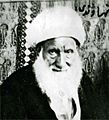Clergy facts for kids

Clergy are some of the main and important formal leaders within certain religions. The roles and functions of clergy vary in different religious traditions but these usually involve presiding over specific rituals and teaching their religion's doctrines and practices. Some of the terms used for individual clergy are cleric, clergyman, clergywoman, clergyperson and churchman.
In Christianity the specific names and roles of clergy vary by denomination and there is a wide range of formal and informal clergy positions, including deacons, priests, bishops, preachers, pastors, ministers and the Pope. In Islam, a religious leader is often known formally or informally as an imam, mufti, mullah or ayatollah. In Jewish tradition, a religious leader is often a rabbi or hazzan (cantor).
"Cleric" comes from the ecclesiastical Latin clericus, for those belonging to the priestly class. This is from the Ecclesiastical Greek clericus, meaning appertaining to an inheritance, in reference to the fact that the Levitical priests of the Old Testament had no inheritance except the Lord.
Current canon law prescribes that to be ordained a priest, an education is required of two years of philosophy and four of theology, including study of dogmatic and moral theology, the Holy Scriptures, and canon law have to be studied within a seminary or an ecclesiastical faculty at a university.
Related Pages
Images for kids
-
14th Dalai Lama, Tenzin Gyatso in 2007
-
Bishop Maurício Andrade, primate of the Anglican Episcopal Church of Brazil, gives a crosier to Bishop Saulo Barros
-
Archbishop Jose S. Palma with his assistant ministers during Pontifical High Mass
-
Orthodox Christian clergy: bishop (right, at altar), priest (left), and two deacons (in gold)
-
Ethiopian Orthodox clergy lead a procession in celebration of Saint Michael
-
The Reverend Hans G. Ridderstedt (1919-2007), Assistant Vicar at Stockholm Cathedral
-
A Sunni jurist (mufti) delivering a sermon from a pulpit
See also
 In Spanish: Clero para niños
In Spanish: Clero para niños













